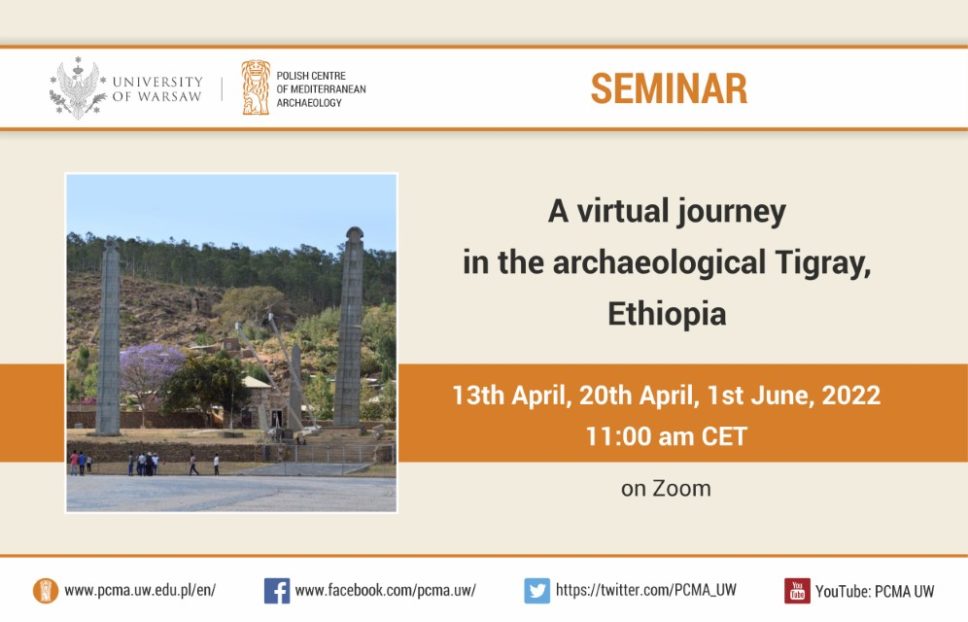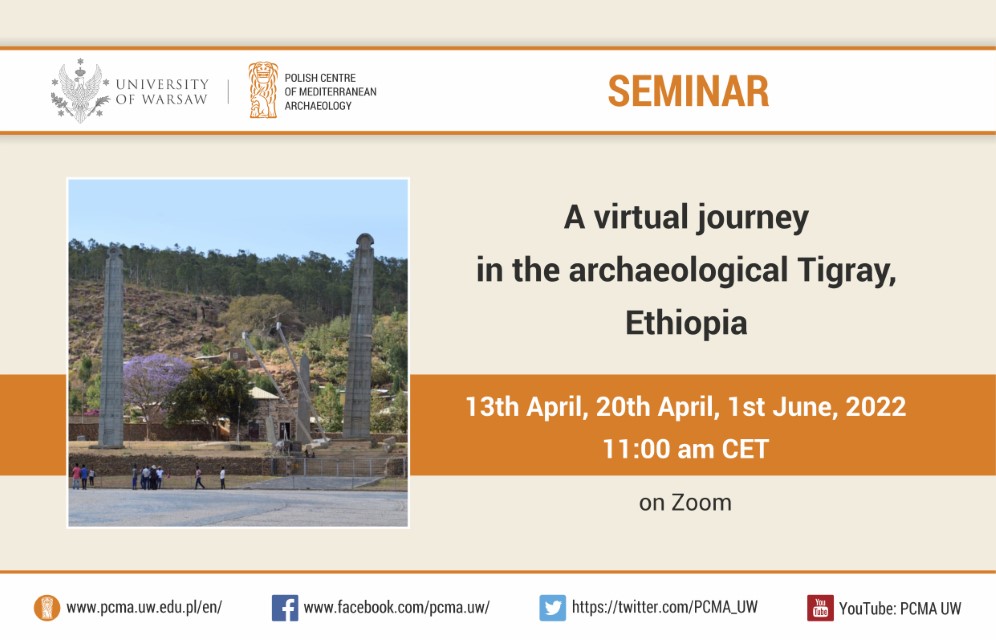A series of lectures on the most important archaeological sites in north Ethiopia will be made available via Zoom. The three-day seminar “A virtual journey in the archaeological Tigray, Ethiopia” is part of a general course “the Archaeology of Ancient Ethiopia: the Aksumite Culture and Civilization” delivered by Dr. Michela Gaudiello of the Polish Centre of Mediterranean Archaeology, University of Warsaw.
The seminar will host invited speakers – the directors of three of the most important archaeological sites in the north Ethiopian region of Tigray. They will present the results of decades of research on their sites.
The lectures will be held on Zoom. To obtain links, please write to Dr. Michela Gaudiello: m.gaudiello@uw.edu.pl
Program (download as PDF):
- Day 1: Wednesday, 13th April, 2022, 11 am CET
Title: A virtual journey in the archaeological Tigray, Ethiopia: SEGLAMEN
Dr. Luisa Sernicola
Research Associate, Department of Asia, Africa and the Mediterranean, University of Naples “L’Orientale”; Co-director, Italian Archaeological Expedition at Aksum
Abstract: Since 2010, the Italian Archaeological Expedition at Aksum of the University of Naples “L’Orientale” and IsMEO (Associazione Internazionale di Studi sul Medietrraneo e l’Oriente) conducts researches at the pre-Aksumite site of Seglamen. Investigations at Seglamen are part of a broader project aimed at reconstructing population history, human-environmental interactions, human mobility and exchange networks in central-western Tigray between the early 1st millennium BCE and the late 1st millennium CE. During the lecture, the results of ten years of investigation will be presented and major issues related to the research questions will be discussed.
- Day 2: Wednesday, 20th April, 2022, 11 am CET
Title: A virtual journey in the archaeological Tigray, Ethiopia: BIETA GIYORGIS
Prof. Dr. Andrea Manzo
Director of the Department of Asia, Africa and the Mediterranean, University of Naples “L’Orientale”, Professor of Nubian Archaeology, Ethiopia Archaeology, and Archaeology of the Nile Valley; Director of Italian Archaeological Expedition to Eastern Sudan and co-director of Italian Archaeological Expedition at Aksum
Abstract: In 1993 the Italian Archaeological Expedition at Aksum resumed fieldwork after a gap of about twenty years due to the Ethiopian civil war against the Derg regime. The resumption of the activities in the field consisted of a research project conducted in tight collaboration with Boston University at Bieta Giyorgis, a hill immediately north of Aksum, under the direction of R. Fattovich and K.A. Bard. Investigations were conducted by the Italian-American team at Ona Enda Aboi Zewge and Ona Nagast, respectively a cemetery and a settlement. These research activities provided the first evidence for a new phase of the cultural and chronological sequence of the Aksum region, the Proto-Aksumite (3rd–1st century BCE), throwing light on the origins of the Aksumite culture. Moreover, the investigation of other sites recorded on the hill and around it provided crucial insights into the socio-economic and cultural processes affecting the Aksum region between the 1st millennium BCE and the 1st millennium CE. The main results of the project will be outlined and discussed in the presentation.
- Day 3: Wednesday, 1st June, 2022, 11 am CET
Title: A virtual journey in the archaeological Tigray, Ethiopia: YEHA, The Formation of a Complex Society in the Early 1st Millennium BC
Dr. Iris Gerlach, Dr. Sarah Japp, and Dipl. Eng. Mike Schnelle
Deutsches Archäologisches Institut, Berlin
Abstract: In the early 1st millennium BC the migration of Sabaean populations from the region around Marib in present-day Yemen led to the formation of a complex society in the northern Horn of Africa. Economic interests, such as the lucrative trade in gold, obsidian as well as incense were probably the reasons for the founding of settlements on the African side of the Red Sea.
Social as well as technical innovations stemming from South Arabia shaped a culture called Ethio-Sabaean for about 300 years. Among the social changes was, for instance, the adoption of political and religious institutions of the Sabaeans; among the technical ones were the introduction of the Sabaean script and language, as well as the implementation of South Arabian architectural forms.


